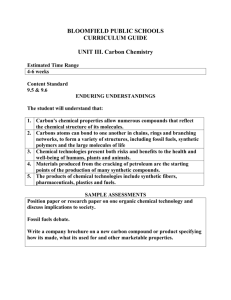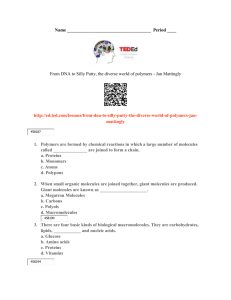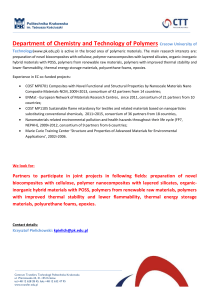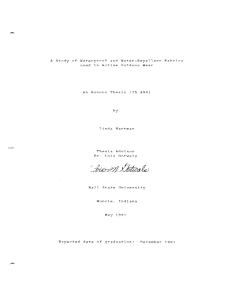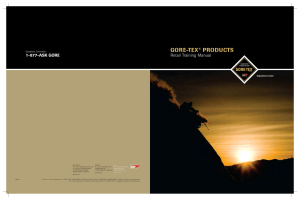Polymers in everyday things – mountaineering
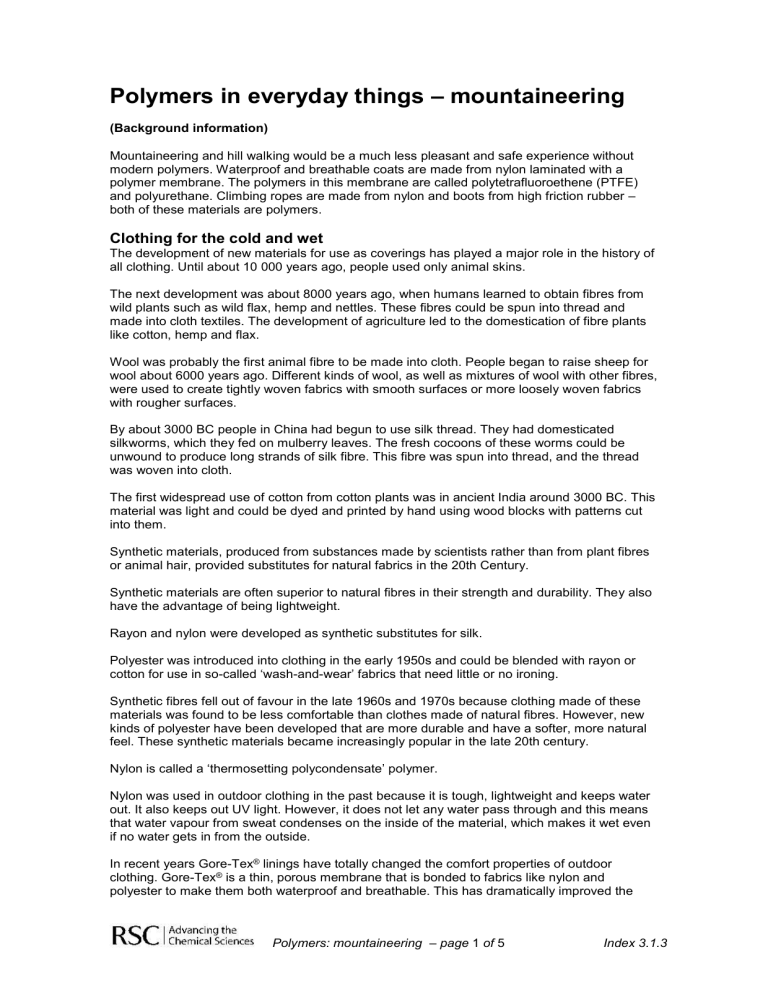
Polymers in everyday things – mountaineering
(Background information)
Mountaineering and hill walking would be a much less pleasant and safe experience without modern polymers. Waterproof and breathable coats are made from nylon laminated with a polymer membrane. The polymers in this membrane are called polytetrafluoroethene (PTFE) and polyurethane. Climbing ropes are made from nylon and boots from high friction rubber – both of these materials are polymers.
Clothing for the cold and wet
The development of new materials for use as coverings has played a major role in the history of all clothing. Until about 10 000 years ago, people used only animal skins.
The next development was about 8000 years ago, when humans learned to obtain fibres from wild plants such as wild flax, hemp and nettles. These fibres could be spun into thread and made into cloth textiles. The development of agriculture led to the domestication of fibre plants like cotton, hemp and flax.
Wool was probably the first animal fibre to be made into cloth. People began to raise sheep for wool about 6000 years ago. Different kinds of wool, as well as mixtures of wool with other fibres, were used to create tightly woven fabrics with smooth surfaces or more loosely woven fabrics with rougher surfaces.
By about 3000 BC people in China had begun to use silk thread. They had domesticated silkworms, which they fed on mulberry leaves. The fresh cocoons of these worms could be unwound to produce long strands of silk fibre. This fibre was spun into thread, and the thread was woven into cloth.
The first widespread use of cotton from cotton plants was in ancient India around 3000 BC. This material was light and could be dyed and printed by hand using wood blocks with patterns cut into them.
Synthetic materials, produced from substances made by scientists rather than from plant fibres or animal hair, provided substitutes for natural fabrics in the 20th Century.
Synthetic materials are often superior to natural fibres in their strength and durability. They also have the advantage of being lightweight.
Rayon and nylon were developed as synthetic substitutes for silk.
Polyester was introduced into clothing in the early 1950s and could be blended with rayon or cotton for use in socalled ‘wash-and-wear’ fabrics that need little or no ironing.
Synthetic fibres fell out of favour in the late 1960s and 1970s because clothing made of these materials was found to be less comfortable than clothes made of natural fibres. However, new kinds of polyester have been developed that are more durable and have a softer, more natural feel. These synthetic materials became increasingly popular in the late 20th century.
Nylon is called a ‘thermosetting polycondensate’ polymer.
Nylon was used in outdoor clothing in the past because it is tough, lightweight and keeps water out. It also keeps out UV light. However, it does not let any water pass through and this means that water vapour from sweat condenses on the inside of the material, which makes it wet even if no water gets in from the outside.
In recent years Gore-Tex
®
linings have totally changed the comfort properties of outdoor clothing. Gore-Tex ® is a thin, porous membrane that is bonded to fabrics like nylon and polyester to make them both waterproof and breathable. This has dramatically improved the
Polymers: mountaineering – page 1 of 5 Index 3.1.3
ability of outdoor garments for active people to cope with perspiration wetness and the discomfort it causes.
The Gore-Tex ® lining is full of very small holes called pores: there are 1.4 billion pores per square cm of material. These pores are too small for water droplets to pass through, so rain and snow stay on the outside of the garment. However, the pores are large enough for molecules of water vapour to pass through, which means the fabric is ‘breathable’ because water vapour from sweat can escape.
Gore-Tex
®
liners are made from the polymer PTFE, which is also known as TEFLON
®
and was discovered by Roy Plunkett in 1938. (Refer to RSC publication, Chemists in a Social and
Historical context .)
PTFE is made by polymerising tetrafluoroethene.
F F
CC
F F
In 1969 Bob Gore discovered that PTFE (polytetrafluoroethene) could be stretched to form a strong, porous material called expanded PTFE (ePTFE). It is this stretching that puts the tiny holes into the material. ePTFE is now used in various forms for several different applications, including outdoor clothing. The first waterproof, breathable ePTFE fabric was introduced in 1976 under the name Gore-Tex
®
.
One problem with the ePTFE Gore-Tex
®
layer is that it is too fragile to be used by itself. Instead, it must be combined with other stronger, more durable fabrics to make it useful to active people outdoors.
Modern Gore-Tex ® outdoor wear is usually made of two or more separate layers bonded or sewn together. The best option for people who use Gore-Tex
® fabric with a ‘three-ply’ construction.
a lot is a high quality Gore-Tex
®
This three-ply fabric is usually made by bonding the Gore-Tex
®
(ePTFE) layer to a nylon layer one side and to another material on the other side. The ePTFE is then sandwiched in the middle of a three layer laminate (three-ply) construction. The third layer is usually a light, open weave material chosen to keep weight down and maximise vapour transmission.
The Gore-Tex
®
film is also impregnated with an oil-repelling (oleophobic) compound that helps it resist contamination by body oils. If this were not done, the oils could prevent the Gore-Tex ® fabric from breathing properly.
One problem that has to be overcome in making Gore-Tex
®
clothing is that the holes made by stitching are bigger than the micropores in the Gore-Tex ® layer. These stitching holes need to be sealed.
The ePTFE film layer can crack if it is repeatedly flexed in the same spot, or wear through as a result of rubbing (abrasion) in areas of high wear. Seam sealer applied to noticeable abraded areas will slow or stop leaks.
Campfire sparks would quickly melt large holes all the way through a PTFE laminate.
Polymers: mountaineering – page 2 of 5 Index 3.1.3
3.
Polymers in everyday things – mountaineering
1. Construct a time line to show the development of clothing material.
2. Complete the table shown below
Examples of plants used to make clothing Examples of animals used to make clothing
Different materials are used for clothing in different countries around the world. Some textiles are better suited to a particular climate than others. a. Suggest where wool is most useful. b. c.
Suggest where thin woven cotton is most useful.
Nylon was not used in 3000 BC. Why?
4. Look at the website at http://www.efunda.com/materials/polymers/history/history.cfm?list_order=time
(accessed January 2006).
Find the polymers polyester and nylon on the website and use the information provided to help you complete your own copy of the table below.
Year when first used
What it is used for now
Polyester Nylon
Useful properties
5. Find out the difference between thermosetting and thermoplastic type polymers. You
Polymers: mountaineering – page 3 of 5 Index 3.1.3
11.
9.
8. could use the internet or look in books. If you use the internet, type ‘thermosetting and thermoplastic pol ymers’ into your search engine.
Thermosetting
6.
Thermoplastic
The formation of condensation inside nylon clothing was more of a problem for a mountaineer than for a fisherman sitting on a riverbank. Suggest why.
7. What does the formation of condensation suggest about the size of a particle of water vapour and the size of a droplet of water from rain?
What word describes the small molecules, such as tetrafluoroethene, that combine to make polymers?
What name is given to the group of compounds that contain carbon to carbon double bonds?
10.
Write down the formula of the polytetrafluoroethene molecule made when n molecules of tetrafluoroethene combine.
What must be done to PTFE to change it into a material with very small holes?
12. Write down two ways that a Gore-Tex
®
outdoor jacket could be damaged in use.
13. Explain how Gore-Tex ® linings work. Use the diagram below to help you with your
Polymers: mountaineering – page 4 of 5 Index 3.1.3
answer. Include an explanation of why there are three layers in the fabric.
Outer fabric
Knit layer
Wind/cold/rain
Water vapour
Gore-Tex
®
membrane layer
15.
14.
What problem is overcome by impregnating Gore-Tex
®
linings with oil-repelling
(oleophobic) compounds?
In recent years a fabric for outdoor wear called eVENT ® has appeared on the market.
You can read more about this fabric on the manufacturer’s website: http://www.eventfabrics.com/indexSet.cfm
(accessed January 2006).
In what ways does the manufacturer of this material claim it is better than the older
PTFE lining technology?
Polymers: mountaineering – page 5 of 5 Index 3.1.3




